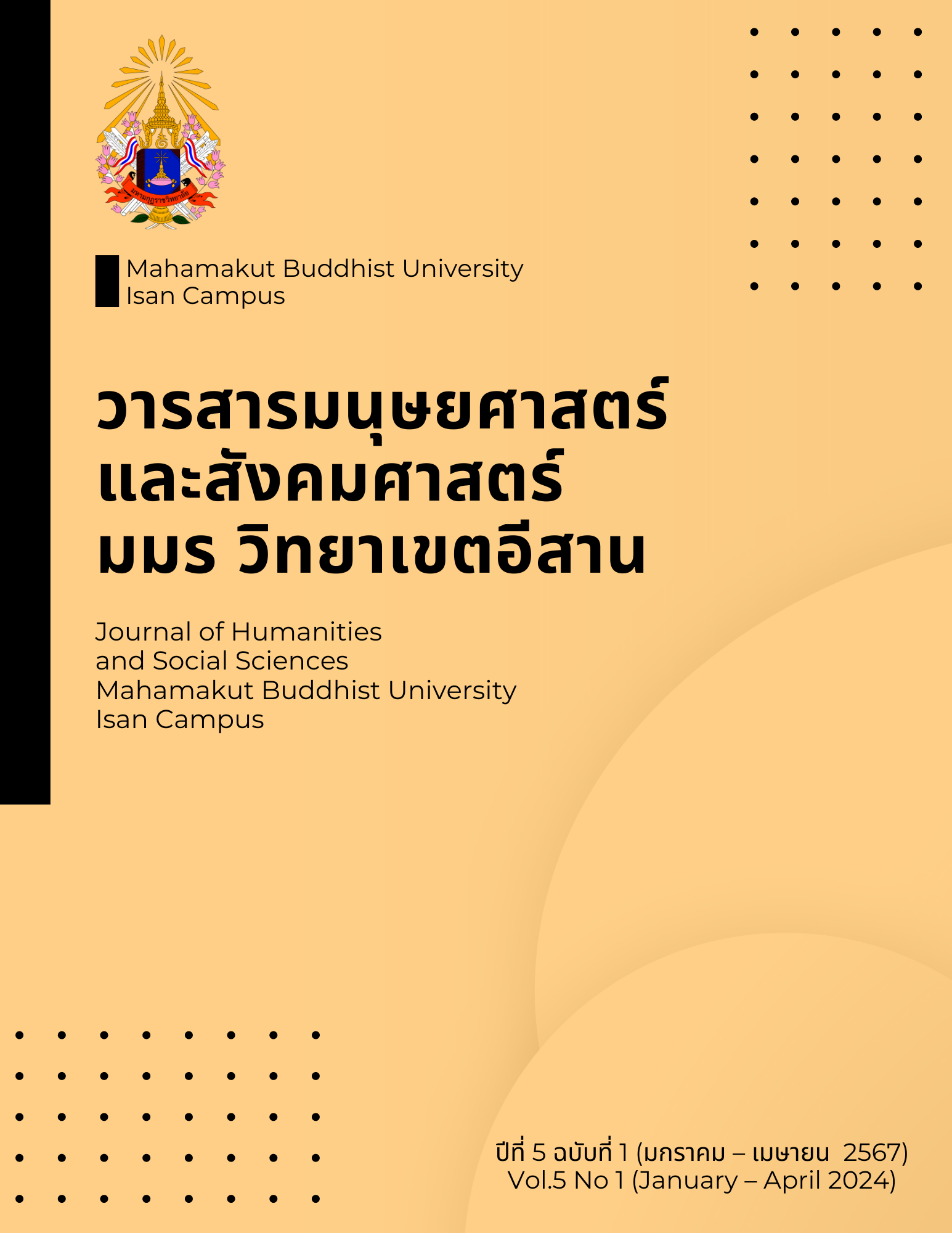THE DEVELOPMENT OF PHYSIC LEARNING ACTIVITIES BASED ON DESIGN THINKING APPROACH STEAM EDUCATION TO ENHANCE DESIGN THINKING COMPETENCY AND INNOVATIVE PRODUCT OF 10th GRADE STUDENTS
Keywords:
Design Thinking, STEAM Education, Design Thinking Competency, Innovative ProductAbstract
The purposes of this study were 1) development of learning activities based on design thinking approach STEAM education. 2) investigate the efficiency of learning activities 3) study the learning achievement before and after Physic learning of 10th grade students. The sample group was simple random sampling technique and comprised of 30 grade 10th students of Kanchananukroh school in the semester 2/2023 using simple random sampling. The research instruments were lesson plans content validity between 0.60-1.00, a design thinking competency assessment test content validity between 0.50-1.00, innovative product assessment test content validity between 0.50-1.00, and learning achievement test content validity between 0.50-1.00. The statistics used to analyze the collected data were percentage, statistical mean, standard deviation, and t-test for dependent samples. The results of the study were found as follows: 1) Four steps to enhance design thinking competency and innovation work of 10th grade students by using Physic leaning activities based on design thinking approach STEAM education developed by the research were step 1: Discovery and Empathy, step 2: Related Information and Define, step 3: Ideate Plan and Prototype, and step 4: Test and Present. The effectiveness was found 83.50/81.33 higher than the expected criterion 80/80. 2) Investigate the efficiency of Physic leaning activities based on design thinking approach STEAM education of 10th grade students in following parts: 2.1) Design thinking competency scores of 10th grade students after using Physic learning activities based on design thinking approach STEAM education overall, it is a good level. 2.2) Innovation work scores of 10th grade students after using Physic learning activities based on design thinking approach STEAM education overall, it is a good level. 3) The posttest of the learning achievement of students learning with based on design thinking approach STEAM education to enhance design thinking competency and innovation work of 10th grade students was higher than the pretest at a significant.
References
กรัณย์พล วิวรรธมงคล. (2560). กระบวนการจัดการเรียนรู้ที่สอดคล้องกับท้องถิ่น. กาญจนบุรี: มหาวิทยาลัยราชภัฏกาญจนบุรี.
จารีพร ผลมูล. (2558). การพัฒนาหน่วยการเรียนรู้บูรณาการแบบ STEAM สำหรับนักเรียนชั้นมัธยมศึกษาปีที่ 3: กรณีศึกษาชุมชนวังตะกอ จังหวัดชุมพร. ปริญญานิพนธ์การศึกษา มหาบัณฑิต, มหาวิทยาลัยศรีนครินทรวิโรฒ.
นภาภรณ์ เจียมทอง และ เปรม วิบูลย์เจริญสุข. (2566). การจัดการเรียนรู้ด้วยการใช้ความคิดเชิงออกแบบสำหรับนักเรียนประถมศึกษา. Journal of Roi Kaensarn Academi, 8(4), 572-586. จาก https://so02.tci-thaijo.org/index.php/JRKSA/article/view/260066/ 175935
ณัฐพงษ์ เทศทอง (2564). ผลการจัดการเรียนรู้สาระวิทยาศาสตร์ตามแนวคิด STEAM เพื่อส่งเสริมความสามารถในการสร้างนวัตกรรมและเจตคติต่อวิทยาศาสตร์ของนักเรียนชั้นมัธยมศึกษาปีที่ 1 (วิทยานิพนธ์ปริญญามหาบัณฑิต), มหาวิทยาลัยศิลปากร. สืบค้นจาก http://ithesis-ir.su.ac.th › dspace › bitstream
ปวีณา ยกพล. (2565). การพัฒนาความสามารถในการสร้างนวัตกรรมทางฟิสิกส์ โดยใช้การจัดการเรียนรู้ด้วยกระบวนการคิดเชิงออกแบบของนักเรียนชั้นมัธยมศึกษาปีที่ 4. วิทยานิพนธ์ปริญญาศึกษาศาสตร์มหาบัณฑิต, มหาวิทยาลัยศิลปากร.
พิชญา กล้าหาญ. (2564). การพัฒนากิจกรรมการเรียนรู้ตามแนวคิดกระบวนการคิดเชิงออกแบบร่วมกับการจัดการเรียนรู้โดยใช้โครงงานเป็นฐาน เพื่อส่งเสริมความเป็นนวัตกรของนักเรียนชั้นมัธยมศึกษาปีที่ 4. วิทยานิพนธ์ปริญญาศึกษาศาสตร์มหาบัณฑิต, มหาวิทยาลัยศิลปากร.
มาเรียม นิลพันธุ์. (2558). วิธีวิจัยทางการศึกษา. พิมพ์ครั้งที่ 9. นครปฐม: โรงพิมพ์มหาวิทยาลัย ศิลปากร.
สถาบันสอนโค้ดจีเนียส. (2566). รู้จักทักษะการแก้ปัญหา problem solving ปั้นเด็กให้ก้าวทันโลกอนาคต. สืบค้น 5 กุมภาพันธ์ 2567, จาก https://codegeniusacademy.com/problem- solving/
สถาบันส่งเสริมการสอนวิทยาศาสตร์และเทคโนโลยี. (2555). ครูวิทยาศาสตร์มืออาชีพ แนวทางสู่การเรียนการสอนที่มีประสิทธิภาพ. กรุงเทพฯ: อินเตอร์เอ็ดดูเคชั่น ซัพพลายส์.
วรรณพงศ์ เตรียมโพธิ์. (2559). ชุดสื่อการเรียนรู้วิชาวิทยาศาสตร์สะเต็มศึกษา เล่มที่ 5. กรุงเทพฯ: โรงเรียนคอมพิวเตอร์อัจริยะภาพ.
วิสูตร โพธิ์เงิน. (2560). STEAM ศิลปะเพื่อสะเต็มศึกษา: การพัฒนาการรับรู้ความสามารถและแรงบันดาลใจให้เด็ก. วารสารครุศาสตร์ จุฬาลงกรณ์มหาวิทยาลัย, 45(1), 320-334.
เอกสิทธิ์ ชนินทรภูมิ (2563). การพัฒนารูปแบบการเรียนการสอนตามแนวคิด STEAM เพื่อส่งเสริมทักษะการสร้างสรรค์นวัตกรรมทางเทคโนโลยีของนักเรียนชั้นมัธยมศึกษา. วิทยานิพนธ์ปรัชญาดุษฎีบัณฑิต, มหาวิทยาลัยศิลปากร.
Alyssa Gallagher. (2016). How to use design thinking in the classroom to build problem-solving skills. Retrieved June 8, 2020, from https://www.teacher-blog.education.com/how=to-use-design-thinking-in-the-classroom-to-build-problem-solving-skills-c42bdfa95ccd#.qb5wd0nf4
Cheri Sterman. (2015). Teaching by design: Design thinking is a problem-solving strategy that help build students 21th century skills. Retrieved June 1, 2020, from https://www.naesp.org/sites/default/files/TechingByDesign_CCAC15.pdf.
The Stanford d.school Bootcamp Bootleg (2010). D.school bootcamp bootleg. Institute of design at Stanford. Retrieved June 1, 2020, from https://dschool. stanford.edu/wp-content/uploads/2011/03/BootcampBootleg2010v2SLM. pdf.
Yakman, G. (2008). STEAM Education: An overview of creating a model of integrative education. Retrieved June 1, 2020, from https://www.academia.edu/8113795/STEAM_Education_an_overview_of_creating_a_model_of_integrative_education.



